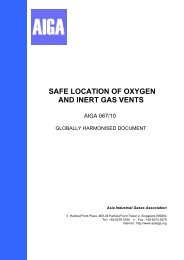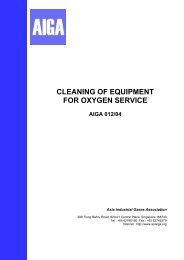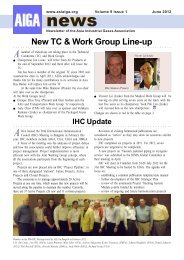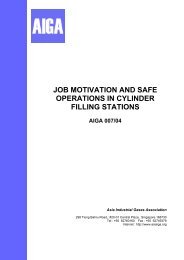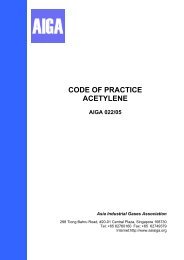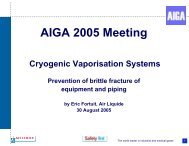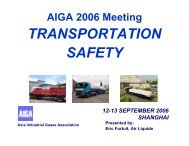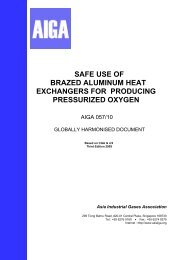Fire hazards of oxygen and oxygen enriched atmospheres - AIGA
Fire hazards of oxygen and oxygen enriched atmospheres - AIGA
Fire hazards of oxygen and oxygen enriched atmospheres - AIGA
You also want an ePaper? Increase the reach of your titles
YUMPU automatically turns print PDFs into web optimized ePapers that Google loves.
FIRE HAZARDS OF OXYGEN AND<br />
OXYGEN ENRICHED<br />
ATMOSPHERES<br />
<strong>AIGA</strong> 005/10<br />
ASIA INDUSTRIAL GASES ASSOCIATION<br />
298 Tiong Bahru Road, #20-01 Central Plaza, Singapore 168730<br />
Tel : +65 6276 0160 • Fax : +65 6274 9379
© Reproduced with permission from the European Industrial Gases Association. All rights reserved.<br />
<strong>AIGA</strong> 005/10<br />
FIRE HAZARDS OF OXYGEN<br />
AND OXYGEN ENRICHED<br />
ATMOSPHERES<br />
PREPARED BY :<br />
ARRIETA, Angel PRAXAIR EUROHOLDING<br />
BRICKELL, Phil THE LINDE GROUP<br />
CAMPARADA, Vincenzo SOL<br />
FRY, Christina AIR PRODUCTS<br />
GACHOT, Roger AIR LIQUIDE<br />
LEWANDOWSKI, Janusz LINDE GAS<br />
NIELSEN, Arvid YARA<br />
PATEL, Milan AIR PRODUCTS<br />
RITLOP, Danilo MESSER GROUP<br />
Disclaimer<br />
All technical publications <strong>of</strong> <strong>AIGA</strong> or under <strong>AIGA</strong>’s name, including Codes <strong>of</strong> practice, Safety procedures <strong>and</strong> any other<br />
technical information contained in such publications were obtained from sources believed to be reliable <strong>and</strong> are based on<br />
technical information <strong>and</strong> experience currently available from members <strong>of</strong> <strong>AIGA</strong> <strong>and</strong> others at the date <strong>of</strong> their issuance.<br />
While <strong>AIGA</strong> recommends reference to or use <strong>of</strong> its publications by its members, such reference to or use <strong>of</strong> <strong>AIGA</strong>’s publications<br />
by its members or third parties are purely voluntary <strong>and</strong> not binding.<br />
Therefore, <strong>AIGA</strong> or its members make no guarantee <strong>of</strong> the results <strong>and</strong> assume no liability or responsibility in connection with<br />
the reference to or use <strong>of</strong> information or suggestions contained in <strong>AIGA</strong>’s publications.<br />
<strong>AIGA</strong> has no control whatsoever as regards, performance or non performance, misinterpretation, proper or improper use <strong>of</strong> any<br />
information or suggestions contained in <strong>AIGA</strong>’s publications by any person or entity (including <strong>AIGA</strong> members) <strong>and</strong> <strong>AIGA</strong><br />
expressly disclaims any liability in connection thereto.<br />
<strong>AIGA</strong>’s publications are subject to periodic review <strong>and</strong> users are cautioned to obtain the latest edition.<br />
ASIA INDUSTRIAL GASES ASSOCIATION<br />
298 Tiong Bahru Road #20-01 Central Plaza Singapore 168730<br />
Tel: +65 62760160 Fax: +65 62749379<br />
Internet: http://www.asiaiga.org
Acknowledgement<br />
<strong>AIGA</strong> 005/10<br />
This document is adopted from the European Industrial Gases Association document IGC Doc<br />
04/09E. ‘<strong>Fire</strong> <strong>hazards</strong> <strong>of</strong> <strong>oxygen</strong> <strong>and</strong> <strong>oxygen</strong> <strong>enriched</strong> <strong>atmospheres</strong>’. Acknowledgement <strong>and</strong> thanks<br />
are hereby given to EIGA for permission granted for the use <strong>of</strong> their document.
<strong>AIGA</strong> 005/10<br />
Table <strong>of</strong> Contents<br />
1 Introduction.......................................................................................................................................1<br />
2 Scope <strong>and</strong> purpose ..........................................................................................................................1<br />
3 Definitions.........................................................................................................................................1<br />
3.1 Oxygen.......................................................................................................................................1<br />
3.2 Pressure.....................................................................................................................................1<br />
4 General properties............................................................................................................................1<br />
4.1 Oxygen supports <strong>and</strong> accelerates combustion..........................................................................1<br />
4.2 Oxygen gives no warning...........................................................................................................1<br />
4.3 Oxygen is heavier than air .........................................................................................................2<br />
5 <strong>Fire</strong> <strong>hazards</strong> with <strong>oxygen</strong> .................................................................................................................2<br />
5.1 Necessary conditions for a fire...................................................................................................2<br />
5.2 Oxygen.......................................................................................................................................2<br />
5.2.1 Oxygen enrichment <strong>of</strong> the atmosphere .............................................................................2<br />
5.2.2 Improper use <strong>of</strong> <strong>oxygen</strong> .....................................................................................................3<br />
5.2.3 Incorrect design <strong>of</strong> <strong>oxygen</strong> system ....................................................................................4<br />
5.2.4 Incorrect operation <strong>and</strong> maintenance <strong>of</strong> <strong>oxygen</strong> equipment .............................................4<br />
5.2.5 Use <strong>of</strong> incorrect materials ..................................................................................................5<br />
5.3 Combustible material .................................................................................................................5<br />
5.4 Ignition sources..........................................................................................................................6<br />
6 Prevention <strong>of</strong> fires in <strong>oxygen</strong> systems..............................................................................................7<br />
6.1 Information/training ....................................................................................................................7<br />
6.2 Proper design.............................................................................................................................7<br />
6.3 Prevention <strong>of</strong> <strong>oxygen</strong> enrichment ..............................................................................................8<br />
6.3.1 Leak testing........................................................................................................................8<br />
6.3.2 Operation <strong>and</strong> practice ......................................................................................................8<br />
6.3.3 Ventilation ..........................................................................................................................8<br />
6.3.4 Vessel entry/ blanking procedures ....................................................................................8<br />
6.3.5 Isolation equipment............................................................................................................9<br />
6.4 Oxygen cleanliness....................................................................................................................9<br />
6.5 Control <strong>of</strong> hot work.....................................................................................................................9<br />
7 Methods <strong>of</strong> <strong>oxygen</strong> detection ...........................................................................................................9<br />
7.1 Measuring Instruments ..............................................................................................................9<br />
7.2 Choice <strong>of</strong> the measuring method.............................................................................................10<br />
7.3 Utilisation <strong>of</strong> measuring instruments........................................................................................10<br />
8 Protection <strong>of</strong> personnel ..................................................................................................................10<br />
8.1 Clothes .....................................................................................................................................10<br />
8.2 Analysis....................................................................................................................................11<br />
8.3 Smoking ...................................................................................................................................11<br />
8.4 First Aid ....................................................................................................................................11<br />
9 Summary <strong>of</strong> recommendations ......................................................................................................11<br />
APPENDIX A .........................................................................................................................................13<br />
APPENDIX B .........................................................................................................................................14<br />
APPENDIX C.........................................................................................................................................26<br />
C 1 Examples <strong>of</strong> <strong>oxygen</strong> enrichment accidents....................................................................................26
<strong>AIGA</strong> 005/10<br />
C 2 Examples <strong>of</strong> improper use <strong>of</strong> <strong>oxygen</strong>.............................................................................................27<br />
C 3 Examples <strong>of</strong> incorrect design <strong>of</strong> <strong>oxygen</strong> system............................................................................27<br />
C 4 Examples <strong>of</strong> Incorrect operation <strong>and</strong> maintenance <strong>of</strong> <strong>oxygen</strong> equipment .....................................28<br />
C 5 Use <strong>of</strong> incorrect materials with <strong>oxygen</strong> service..............................................................................30
1 Introduction<br />
1<br />
<strong>AIGA</strong> 005/10<br />
This document explains the fire <strong>hazards</strong> resulting from h<strong>and</strong>ling <strong>oxygen</strong> <strong>and</strong> the relevant protective<br />
measures that should be taken.<br />
2 Scope <strong>and</strong> purpose<br />
This document consists <strong>of</strong> three parts.<br />
Part I is intended for line managers <strong>and</strong> supervisors. It provides the background to the subject <strong>and</strong> a<br />
description <strong>of</strong> the fire <strong>and</strong> explosion <strong>hazards</strong> associated with <strong>oxygen</strong> <strong>and</strong> <strong>oxygen</strong> <strong>enriched</strong><br />
<strong>atmospheres</strong>.<br />
Part II, is Appendix B, <strong>and</strong> is a summary <strong>of</strong> Part I suitable to be produced as a pamphlet to be h<strong>and</strong>ed<br />
to those involved in daily operations involving <strong>oxygen</strong> or used in training presentations.<br />
Part III, is Appendix C, <strong>and</strong> lists some accidents which have taken place in recent years <strong>and</strong> which<br />
can be used as examples underlining the <strong>hazards</strong> <strong>of</strong> <strong>oxygen</strong> <strong>and</strong> <strong>oxygen</strong> <strong>enriched</strong> <strong>atmospheres</strong>.<br />
It is recommended that the document be used as the basis for training programmes.<br />
3 Definitions<br />
3.1 Oxygen<br />
Oxygen for the purpose <strong>of</strong> this document includes not only pure <strong>oxygen</strong> but all <strong>oxygen</strong>/air mixtures<br />
containing more than 21 % <strong>oxygen</strong>.<br />
3.2 Pressure<br />
In this document “bar” shall indicate gauge pressure unless otherwise noted – i.e. “bar” for absolute<br />
pressure <strong>and</strong> “bar, dif” for differential pressure.<br />
4 General properties<br />
Oxygen, which is essential to life, is not flammable in itself, but supports <strong>and</strong> accelerates combustion.<br />
The normal concentration in the air which we breathe is approximately 21 % by volume.<br />
4.1 Oxygen supports <strong>and</strong> accelerates combustion<br />
Most materials burn fiercely in <strong>oxygen</strong>; the reaction could even be explosive.<br />
As the <strong>oxygen</strong> concentration in air increases the potential fire risk increases.<br />
4.2 Oxygen gives no warning<br />
Oxygen is colourless, odourless <strong>and</strong> has no taste hence the presence <strong>of</strong> an <strong>oxygen</strong> <strong>enriched</strong><br />
atmosphere cannot be detected by normal human senses. Oxygen also does not give any<br />
physiological effects which could alert personnel to the presence <strong>of</strong> <strong>oxygen</strong> enrichment.<br />
Increasing the <strong>oxygen</strong> concentration <strong>of</strong> the air at atmospheric pressure does not constitute a<br />
significant health hazard.
4.3 Oxygen is heavier than air<br />
2<br />
<strong>AIGA</strong> 005/10<br />
Being heavier than air, <strong>oxygen</strong> can accumulate in low lying areas such as pits, trenches or<br />
underground rooms. This is particularly relevant when liquid <strong>oxygen</strong> is spilt. In this case the generated<br />
cold gaseous <strong>oxygen</strong> is three times heavier than air.<br />
5 <strong>Fire</strong> <strong>hazards</strong> with <strong>oxygen</strong><br />
5.1 Necessary conditions for a fire<br />
In general for a fire or explosion to occur three elements are required: combustible material, <strong>oxygen</strong><br />
<strong>and</strong> an ignition source.<br />
The “fire triangle” is the normal way <strong>of</strong> representing these conditions:<br />
When one <strong>of</strong> the 3 elements is missing a fire cannot occur.<br />
5.2 Oxygen<br />
Combustible<br />
Material<br />
Oxygen reacts with most materials. The higher the <strong>oxygen</strong> concentration <strong>and</strong> pressure in the<br />
atmosphere or in an <strong>oxygen</strong> system then:<br />
a) the more vigorously the combustion reaction or fire takes place;<br />
b) the lower the ignition temperature <strong>and</strong> the ignition energy to get the combustion reaction<br />
started;<br />
c) the higher the flame temperature <strong>and</strong> destructive capability <strong>of</strong> the flame.<br />
Causes <strong>of</strong> <strong>oxygen</strong> fires can be categorised as follows:<br />
a) <strong>oxygen</strong> enrichment <strong>of</strong> the atmosphere;<br />
b) improper use <strong>of</strong> <strong>oxygen</strong><br />
c) incorrect design <strong>of</strong> <strong>oxygen</strong> systems<br />
d) incorrect operation <strong>and</strong> maintenance <strong>of</strong> <strong>oxygen</strong> systems<br />
e) use <strong>of</strong> materials incompatible with <strong>oxygen</strong> service<br />
5.2.1 Oxygen enrichment <strong>of</strong> the atmosphere<br />
Oxygen<br />
Oxygen enrichment <strong>of</strong> the atmosphere can be the result <strong>of</strong>:<br />
a) Leaking pipe connections, flanges, etc. This can be particularly hazardous in areas where<br />
there is not sufficient ventilation thus causing the <strong>oxygen</strong> concentration to increase;<br />
Ignition
3<br />
<strong>AIGA</strong> 005/10<br />
b) Breaking into systems under <strong>oxygen</strong> pressure.<br />
A sudden release <strong>of</strong> <strong>oxygen</strong> under pressure can result in a relatively large jet <strong>of</strong> escaping<br />
<strong>oxygen</strong>. This may result in a torching fire.<br />
c) Oxygen used in cutting <strong>and</strong> welding processes.<br />
In processes such as cutting, gouging, scaring <strong>and</strong> thermal lancing, <strong>oxygen</strong> is used, in<br />
quantities greater than necessary for the burning process. The unused <strong>oxygen</strong> remains in the<br />
atmosphere, <strong>and</strong> if ventilation is inadequate the air can become <strong>enriched</strong> with <strong>oxygen</strong>.<br />
d) Oxygen used in metallurgical processes.<br />
Incorrect practice in the use <strong>of</strong> blowpipes can lead to <strong>oxygen</strong> enrichment, especially in<br />
confined spaces.<br />
e) Desorption.<br />
Oxygen can be released in appreciable quantities when cold materials which have absorbed<br />
<strong>oxygen</strong> such as absorbents (molecular sieve, silica gel, etc.) or insulation materials are<br />
warmed to room temperature.<br />
f) Cryogenic liquid spill.<br />
A spill <strong>of</strong> liquid <strong>oxygen</strong> creates a dense cloud <strong>of</strong> <strong>oxygen</strong> <strong>enriched</strong> air when evaporating. In an<br />
open space hazardous <strong>oxygen</strong> concentration usually exists only within the visible cloud<br />
associated with the spill.<br />
The cold gas may collect in nearby low lying spaces such as ditches or drains, which are not<br />
well ventilated; atmospheric checks should also be carried on such any nearby spaces after a<br />
spill.<br />
g) Liquefaction <strong>of</strong> air.<br />
When using cryogenic gases with boiling points lower than <strong>oxygen</strong>, e.g. nitrogen, hydrogen<br />
<strong>and</strong> helium, <strong>oxygen</strong> enrichment can also occur.<br />
Ambient air will condense on uninsulated equipment where the temperature is lower than the<br />
liquefaction temperature <strong>of</strong> air (approx –193 °C). This will also occur on pipework lagged with<br />
an open cell insulant. The liquid air so produced can contain up to 50 % <strong>oxygen</strong> <strong>and</strong>, if this<br />
liquid drips <strong>of</strong>f <strong>and</strong> evaporates, the <strong>oxygen</strong> concentration in the last remaining portion can be<br />
over 80 %.<br />
h) Oxygen vents.<br />
Areas near <strong>oxygen</strong> vents can be particularly hazardous. A sudden release <strong>of</strong> <strong>oxygen</strong> can<br />
occur without warning. Note that the non-cryogenic production <strong>of</strong> <strong>oxygen</strong> or nitrogen might<br />
involve an occasional or continuous venting <strong>of</strong> <strong>oxygen</strong>. See <strong>AIGA</strong> 067/10, ‘Safe location <strong>of</strong><br />
<strong>oxygen</strong> <strong>and</strong> inert vents’.<br />
5.2.2 Improper use <strong>of</strong> <strong>oxygen</strong><br />
Serious accidents have been caused by the use <strong>of</strong> <strong>oxygen</strong> for applications for which it was not<br />
intended.<br />
Examples <strong>of</strong> improper use <strong>of</strong> <strong>oxygen</strong> are:<br />
a) Powering pneumatic tools<br />
b) Inflating vehicle tyres, rubber boats, etc.<br />
c) Pressurising <strong>and</strong> purging systems<br />
d) Replacing air or inert gas<br />
e) Cooling or refreshing the air in confined spaces<br />
f) Blowing <strong>oxygen</strong> inside clothing e.g. by a welder in an attempt to create a cooling breeze<br />
g) Removing dust from benches, machinery <strong>and</strong> clothing<br />
h) Starting diesel engines
4<br />
<strong>AIGA</strong> 005/10<br />
In each case the fire <strong>and</strong> explosive risk is the same <strong>and</strong> results from exposing combustible materials<br />
e.g. flammable gases, flammable solids, rubbers, textiles, oils <strong>and</strong> greases to <strong>oxygen</strong>.<br />
5.2.3 Incorrect design <strong>of</strong> <strong>oxygen</strong> system<br />
The proper design <strong>of</strong> <strong>oxygen</strong> installations is critical. Inadequate designs can <strong>and</strong> have lead to serious<br />
accidents.<br />
Examples <strong>of</strong> inadequate design<br />
a) Use <strong>of</strong> rapidly opening (ball) valves. This can lead to ignition caused by the heat generated by<br />
high velocity gas or adiabatic compression, (see below).<br />
b) Allowing too high a gas velocity which can cause ignition <strong>of</strong> incompatible materials in the<br />
system due to particle impact, etc.<br />
c) Opening the main shut <strong>of</strong>f valve in an <strong>oxygen</strong> supply pipeline without equalising the pressure<br />
before.<br />
d) High pressure gas in the presence <strong>of</strong> sharp edged orifices, rapid expansions or reductions.<br />
e) Poorly located vents causing accumulation <strong>of</strong> <strong>oxygen</strong> in the vicinity.<br />
5.2.4 Incorrect operation <strong>and</strong> maintenance <strong>of</strong> <strong>oxygen</strong> equipment<br />
Incorrect operation <strong>and</strong> maintenance <strong>of</strong> <strong>oxygen</strong> equipment is one <strong>of</strong> the most frequent causes <strong>of</strong> fires<br />
in <strong>oxygen</strong> systems.<br />
Examples <strong>of</strong> Incorrect Operation<br />
a) Failing to reset pressure regulators to the closed position when the <strong>oxygen</strong> cylinder valve has<br />
been closed. This results in extremely high <strong>oxygen</strong> gas velocities when pressurising the<br />
regulator next time it is used.<br />
b) Rapid opening <strong>of</strong> valves can result in momentarily high <strong>oxygen</strong> velocities, sufficient to project<br />
any debris present in the system through the system, at sonic velocity causing frictional heat,<br />
sparks, etc..<br />
c) Opening a valve rapidly against a closed valve (or pressure regulator) downstream in a<br />
system – high heat can be generated through adiabatic compression <strong>of</strong> the <strong>oxygen</strong> causing a<br />
fire.<br />
d) Start-up <strong>of</strong> an <strong>oxygen</strong> compressor erroneously with <strong>oxygen</strong>. (This is incorrect operation only<br />
relevant to special cases – see references 7 <strong>and</strong> 8)<br />
Examples <strong>of</strong> Incorrect maintenance<br />
a) Working on pressurised systems.<br />
b) Venting <strong>oxygen</strong> into restricted, enclosed or confined spaces.<br />
c) Allowing systems to become contaminated. Contamination by particulate matter, dust, s<strong>and</strong>,<br />
oils, greases or general atmospheric debris creates a potential fire hazard. Portable<br />
equipment is particularly susceptible to contamination <strong>and</strong> precautions shall be taken to<br />
prevent ingress <strong>of</strong> dirt, oil, etc.<br />
d) Failure to completely remove cleaning solvents from components which are to be used in<br />
<strong>oxygen</strong> service. The solvent residues are not compatible with an <strong>oxygen</strong> <strong>enriched</strong><br />
atmosphere.
5.2.5 Use <strong>of</strong> incorrect materials<br />
5<br />
<strong>AIGA</strong> 005/10<br />
Design <strong>of</strong> <strong>oxygen</strong> equipment is very complex <strong>and</strong> the “why <strong>and</strong> how” is not always obvious. In<br />
essence nearly all materials are combustible in <strong>oxygen</strong>. Safe equipment for <strong>oxygen</strong> service is<br />
achieved by careful selection <strong>of</strong> suitable materials or combination <strong>of</strong> materials <strong>and</strong> their use in a<br />
particular manner.<br />
Any modifications to a design must be properly authorised to prevent incompatible materials being<br />
used.<br />
Substituting materials which look similar is extremely dangerous <strong>and</strong> many accidents are reported<br />
where the cause was incompatible replacement parts. Examples <strong>of</strong> this practice could be:<br />
a) Replacing o-rings <strong>and</strong> gaskets with similar looking items. There are hundreds <strong>of</strong> different<br />
types <strong>of</strong> elastomers <strong>and</strong> most are not compatible with <strong>oxygen</strong>.<br />
b) Replacing a metal alloy with a similar type <strong>of</strong> alloy. The composition <strong>of</strong> particular alloys has a<br />
significant effect on its mechanical properties <strong>and</strong> <strong>oxygen</strong> compatibility. “Bronze”, which<br />
covers a wide range <strong>of</strong> alloys, has several varieties that are compatible with <strong>oxygen</strong> <strong>and</strong> even<br />
more which are not; e.g. tin bronze is used in liquid <strong>oxygen</strong> pumps while aluminium bronze is<br />
considered hazardous.<br />
c) Replacing PTFE tape with a similar white tape. Not all white tape is PTFE <strong>and</strong> not all br<strong>and</strong>s<br />
<strong>of</strong> PTFE tape are safe for use in <strong>oxygen</strong>., see EIGA Doc 138, PTFE Tape as a sealant for<br />
Cylinder/Valve Connections<br />
d) Replacing parts/components with non-approved equipment is not allowed. The geometry <strong>of</strong><br />
certain components is sometimes critical <strong>and</strong> approved manufacturer’s parts shall always be<br />
used when maintaining <strong>oxygen</strong> equipment.<br />
e) Replacing or installation <strong>of</strong> combustible material in filters e.g. plastics, paper, adhesives.<br />
Filters in <strong>oxygen</strong> systems are very sensitive to ignition due to presence <strong>of</strong> particles <strong>and</strong><br />
complicated flow conditions. Therefore filters should be made <strong>of</strong> materials that dem<strong>and</strong> very<br />
high ignition energy e.g. Monel.<br />
f) Lubricants are generally not allowed in <strong>oxygen</strong> service except for special applications.<br />
Specialist expert advice shall always be obtained before applying such lubricants.<br />
5.3 Combustible material<br />
In <strong>oxygen</strong> <strong>enriched</strong> <strong>atmospheres</strong><br />
Materials that do not burn in air including fire resistant materials, can burn vigorously in <strong>oxygen</strong><br />
<strong>enriched</strong> air or pure <strong>oxygen</strong>.<br />
In <strong>enriched</strong> <strong>oxygen</strong> <strong>atmospheres</strong> a common combustible material that most directly affects safety <strong>of</strong><br />
personnel is clothing. All clothing materials will burn fiercely in an <strong>oxygen</strong> <strong>enriched</strong> atmosphere. The<br />
same applies to plastics <strong>and</strong> elastomers.<br />
An example <strong>of</strong> this increased reactivity can be seen below, for cotton overall material exposed to fire<br />
in <strong>atmospheres</strong> containing increasing levels <strong>of</strong> <strong>oxygen</strong> (Ref. No. 8).
RATE OF<br />
BURNING<br />
CM/S<br />
16<br />
14<br />
12<br />
10<br />
8<br />
6<br />
4<br />
2<br />
6<br />
30 40 50<br />
OXYGEN IN ATMOSPHERE %<br />
<strong>AIGA</strong> 005/10<br />
Similar curves, indicating the same kind <strong>of</strong> behaviour could be drawn for other materials – in particular<br />
for plastics <strong>and</strong> elastomers.<br />
In pressurised <strong>oxygen</strong> systems<br />
In principle all organic materials will burn in <strong>oxygen</strong> <strong>and</strong> so do most <strong>of</strong> the metals <strong>and</strong> metal alloys.<br />
Pressure affects the behaviour <strong>of</strong> materials, e.g. by reducing ignition temperatures <strong>and</strong> increasing<br />
combustion rates. It is for these reasons that pressurised <strong>oxygen</strong> systems are only allowed to be<br />
constructed from materials <strong>and</strong> equipment whose design has been approved for the relevant<br />
operating conditions.<br />
Oil <strong>and</strong> grease are particularly hazardous in the presence <strong>of</strong> <strong>oxygen</strong> as they can ignite extremely<br />
easily <strong>and</strong> burn with explosive violence. In <strong>oxygen</strong> equipment, oil <strong>and</strong> grease ignition <strong>of</strong>ten causes a<br />
chain reaction, which finally results in metal burning or melting. In such cases the molten or burned<br />
metal residue is projected away from the equipment <strong>and</strong> may be followed by an <strong>oxygen</strong> release. This<br />
in turn can lead to fierce <strong>and</strong> rapidly spreading flames in any adjacent combustible material external<br />
to the equipment. Hydrocarbon oil <strong>and</strong> grease shall never be used to lubricate equipment that will be<br />
in contact with <strong>oxygen</strong>, <strong>and</strong> any lubricants shall have been approved for the application<br />
5.4 Ignition sources<br />
In <strong>oxygen</strong> <strong>enriched</strong> <strong>atmospheres</strong><br />
Ignition sources in <strong>oxygen</strong> <strong>enriched</strong> conditions could be:<br />
a) Open fires or naked flames (cigarettes, welding or other hot work, petrol driven engines,<br />
furnaces etc.)<br />
b) Electrical sparks<br />
c) Grinding or frictional sparks<br />
In pressurised <strong>oxygen</strong> systems<br />
In systems containing <strong>oxygen</strong> under pressure the potential sources <strong>of</strong> ignition are not as obvious as<br />
naked flames <strong>and</strong> hot surfaces.<br />
The following ignition sources have caused fires in <strong>oxygen</strong> systems:<br />
a) Heating by adiabatic compression<br />
b) Friction<br />
c) Mechanical impact<br />
d) Electrical sparks
e) High gas velocity with presence <strong>of</strong> particles<br />
6 Prevention <strong>of</strong> fires in <strong>oxygen</strong> systems<br />
6.1 Information/training<br />
7<br />
<strong>AIGA</strong> 005/10<br />
Any personnel using <strong>oxygen</strong> equipment should be aware <strong>of</strong> the <strong>hazards</strong>. The minimum information for<br />
safe use <strong>of</strong> <strong>oxygen</strong> is included in <strong>AIGA</strong> 009/10 “Safety training <strong>of</strong> employees”.<br />
All personnel should also have read the safety data sheet <strong>and</strong> safety information provided by the gas<br />
supplier.<br />
For a greater insight into the <strong>hazards</strong> <strong>of</strong> <strong>oxygen</strong> with materials the following information is also<br />
recommended:<br />
a) “Oxygen pipeline systems” <strong>AIGA</strong> 021/05<br />
b) “Prevention <strong>of</strong> hose failures in high pressure gas systems” IGC Doc 42<br />
c) “Reciprocating compressors for <strong>oxygen</strong> service. Code <strong>of</strong> practice” <strong>AIGA</strong> 048/08<br />
d) “Installation guide stationary, electric motor driven centrifugal <strong>oxygen</strong> pumps” <strong>AIGA</strong> 55/08<br />
e) “Centrifugal compressors for <strong>oxygen</strong> service. Code <strong>of</strong> practice” IGC Doc 27<br />
f) SAG Info 15: “Safety principles <strong>of</strong> high pressure <strong>oxygen</strong> systems”.<br />
g) Flammability <strong>and</strong> sensitivity <strong>of</strong> materials in <strong>oxygen</strong>-<strong>enriched</strong> <strong>atmospheres</strong> – American Society<br />
for Testing & Materials (ASTM) symposium series<br />
h) “Cleaning <strong>of</strong> equipment for <strong>oxygen</strong> service” <strong>AIGA</strong> 012/04<br />
i) “Selection <strong>of</strong> personal protective equipment” <strong>AIGA</strong> 066/10<br />
j) “<strong>Fire</strong> Hazards <strong>of</strong> Oxygen Enriched <strong>atmospheres</strong>” TP 12<br />
All maintenance <strong>and</strong> repair work shall be performed by experienced <strong>and</strong> fully trained personnel.<br />
All persons who work in areas where <strong>oxygen</strong> enrichment can occur shall be given adequate<br />
instructions as to the risks involved. Special emphasis on shall be given drawn to the insidious nature<br />
<strong>of</strong> the risks <strong>and</strong> to the almost immediate consequences. Practical training shall be given in the means<br />
by which such risks can be minimised, stressing the importance <strong>of</strong> identifying sources <strong>of</strong> <strong>oxygen</strong><br />
enrichment <strong>and</strong> their isolation.<br />
6.2 Proper design<br />
In <strong>oxygen</strong> systems only equipment that has been specifically designed for <strong>oxygen</strong> shall be used, e.g.<br />
nitrogen regulators shall not be used in <strong>oxygen</strong> service. The proper design <strong>of</strong> equipment intended for<br />
<strong>oxygen</strong> service takes into account materials to be used <strong>and</strong> their configuration, in order to minimise<br />
any risk <strong>of</strong> ignition. The reasons for a particular design <strong>and</strong> choice <strong>of</strong> material are not always obvious<br />
<strong>and</strong> expert advice shall be sought before considering a change <strong>of</strong> materials.<br />
Oxygen equipment shall never be lubricated with oil or grease. For specific, well defined cases, a few<br />
special lubricants may be available. Specialist advice from the supplier shall always be sought.<br />
Oxygen systems shall be designed in such a way, that the flow velocity is as low as possible. If the<br />
velocity is doubled the energy <strong>of</strong> a particle in the gas stream will increase four times.
8<br />
<strong>AIGA</strong> 005/10<br />
Oxygen systems should be positioned in well ventilated areas away from primary ignition sources<br />
such as boilers, etc. Liquid systems should be located away from cable trenches, drains <strong>and</strong> ditches.<br />
6.3 Prevention <strong>of</strong> <strong>oxygen</strong> enrichment<br />
6.3.1 Leak testing<br />
Newly assembled equipment for <strong>oxygen</strong> service shall be thoroughly leak checked using air or nitrogen<br />
e.g. by timed gas pressure drop test, leak detection test (e.g. with approved leak spray or diluted soap<br />
solution) or other suitable methods, see <strong>AIGA</strong> 070/10, Leak detection fluids, gas cylinder packages.<br />
Periodic retests to check for leaks are recommended.<br />
6.3.2 Operation <strong>and</strong> practice<br />
When the work period is over the main <strong>oxygen</strong> supply valve shall be closed to avoid possible <strong>oxygen</strong><br />
leakage when the equipment is not being used.<br />
Filters, where fitted, shall not be removed to obtain higher flows. Filters should be inspected at<br />
frequent intervals <strong>and</strong> all debris removed.<br />
6.3.3 Ventilation<br />
Rooms where there is a risk <strong>of</strong> <strong>oxygen</strong> enrichment <strong>of</strong> the atmosphere shall be well ventilated.<br />
Examples <strong>of</strong> such rooms are:<br />
a) Filling stations<br />
b) Rooms in which <strong>oxygen</strong> vessels or cylinders are stored, h<strong>and</strong>led, maintained, etc.<br />
c) Rooms in which <strong>oxygen</strong> is used or analysed<br />
d) Rooms for medical treatment with <strong>oxygen</strong> in hospitals, home care, etc.<br />
In many cases natural ventilation can be sufficient e.g. in halls or rooms provided with ventilation<br />
openings. The openings should have a flow area greater than 1/100 <strong>of</strong> the room’s floor area, be<br />
diagonally opposite each other <strong>and</strong> shall ensure a free air circulation with no obstructions. Where<br />
natural ventilation is not possible a ventilation unit, with a capacity <strong>of</strong> approximately 6 air<br />
changes/hour shall be provided. Special consideration shall be given to the ventilation <strong>of</strong> underground<br />
rooms, vessels, pits, ducts <strong>and</strong> trenches. There shall be a safety warning to indicate if the ventilation<br />
unit fails.<br />
6.3.4 Vessel entry/ blanking procedures<br />
Prior to entry into any vessel which is connected to a gas source other than air, the vessel shall be<br />
emptied, disconnected from such a source by the removal <strong>of</strong> a section <strong>of</strong> pipe, by the use <strong>of</strong> a<br />
spectacle plate or by inserting blind flanges <strong>and</strong> the space shall be thoroughly ventilated so as to<br />
maintain a normal atmosphere. Piping lock-out devices need to be documented in the Hazardous<br />
Work Permit. Reliance on the closure <strong>of</strong> valves to prevent <strong>oxygen</strong> enrichment is not sufficient.<br />
Permission to enter such a space subsequent to completing the steps indicated above shall be given<br />
only after the issue <strong>of</strong> an entry permit certificate signed by a responsible person. An analysis <strong>of</strong> the<br />
vessel atmosphere shall always be requested as part <strong>of</strong> the work permit requirements.
6.3.5 Isolation equipment<br />
9<br />
<strong>AIGA</strong> 005/10<br />
When an <strong>oxygen</strong> pipeline enters a building, an isolation valve should be provided outside the building<br />
in an accessible position for operation. This valve <strong>and</strong> location shall be clearly marked <strong>and</strong> identified.<br />
The purpose is to enable operation <strong>of</strong> the valve from a safe location, in the event <strong>of</strong> an <strong>oxygen</strong><br />
release inside the building.<br />
Disused <strong>oxygen</strong> lines should either be dismantled or completely severed <strong>and</strong> blanked <strong>of</strong>f from the<br />
supply system.<br />
6.4 Oxygen cleanliness<br />
One <strong>of</strong> the fundamental safety procedures in preventing <strong>oxygen</strong> fires is to ensure that all equipment is<br />
properly cleaned before it is put into <strong>oxygen</strong> service. There are several methods for cleaning <strong>oxygen</strong><br />
equipment. The <strong>AIGA</strong> 012/04 “Cleaning <strong>of</strong> Equipment for Oxygen Service” covers this subject in<br />
detail.<br />
Oxygen equipment also must be free <strong>of</strong> solid particles. In order to remove particles new <strong>oxygen</strong><br />
equipment before start-up shall be purged with oil free air or nitrogen.<br />
6.5 Control <strong>of</strong> hot work<br />
Any hot work which has to be performed close to any <strong>oxygen</strong> equipment or in an area where <strong>oxygen</strong><br />
enrichment could occur shall be controlled by a written permission (hot work permit), which is part <strong>of</strong><br />
the work permit system. Hot work includes operations such as welding, brazing, drilling, grinding, etc.<br />
7 Methods <strong>of</strong> <strong>oxygen</strong> detection<br />
The method selected must <strong>of</strong>fer a high degree <strong>of</strong> reliability <strong>of</strong> operation <strong>and</strong> be sufficiently sensitive to<br />
provide warning before a hazardous concentration <strong>of</strong> <strong>oxygen</strong> is reached. The normal method is to use<br />
an approved atmospheric monitoring instrument to confirm the effectiveness <strong>of</strong> the isolation <strong>and</strong><br />
purging procedures prior to entry into the area, <strong>and</strong> periodically during the course <strong>of</strong> the working to<br />
confirm that changes have not occurred.<br />
A possible method <strong>of</strong> <strong>oxygen</strong> detection could be odorisation. Odorisation is occasionally used in<br />
shipyards, because there is a real risk <strong>of</strong> <strong>oxygen</strong> enrichment when welding in restricted spaces inside<br />
ships. (For details see Ref.9). However, odorisation must only be viewed as a possible supplement to<br />
effective risk analysis, isolation <strong>and</strong> atmospheric monitoring, not as an alternative to them.<br />
7.1 Measuring Instruments<br />
Oxygen measuring instruments should be used as warning devices only, <strong>and</strong> should not be regarded<br />
as protection against the risks <strong>of</strong> <strong>oxygen</strong> enrichment. They should be seen as an addition to normal<br />
good practice <strong>of</strong> eliminating the causes <strong>of</strong> enrichment. Appropriate measuring instruments for the<br />
determination <strong>of</strong> the <strong>oxygen</strong> content indicate an increase as well as a decrease <strong>of</strong> the <strong>oxygen</strong><br />
concentration in the ambient atmosphere <strong>and</strong> have, for example, a range from 0 to 40 % by volume <strong>of</strong><br />
<strong>oxygen</strong>.
10<br />
<strong>AIGA</strong> 005/10<br />
Various measuring techniques <strong>and</strong> methods are used giving visible <strong>and</strong>/or audible warning <strong>and</strong> they<br />
can be used for continuous or intermittent measurement.<br />
7.2 Choice <strong>of</strong> the measuring method<br />
When working in rooms where the <strong>oxygen</strong> content can rise to a dangerous level continuous<br />
measuring methods shall be used during the working time.<br />
Intermittent measurement should only be chosen if it is considered that the rate <strong>of</strong> build up <strong>of</strong> <strong>oxygen</strong><br />
in the atmosphere is slow enough to allow an increase to be detected well before a dangerous level is<br />
reached. The time interval between measurements needs to be carefully chosen to ensure an<br />
appropriate safety margin. Instruments should be checked in fresh air before use <strong>and</strong> adjusted in<br />
accordance with the manufacturer’s instructions.<br />
7.3 Utilisation <strong>of</strong> measuring instruments<br />
The directions <strong>of</strong> the manufacturers for the use <strong>and</strong> maintenance <strong>of</strong> the measuring instruments shall<br />
be carefully observed.<br />
The measuring instrument shall be located in the working area <strong>and</strong> as near as possible to the worker.<br />
In confined spaces, it is recommended that the worker is equipped with a personal monitor attached<br />
to his working clothes which will give an audible <strong>and</strong>/or visual alarm if the <strong>oxygen</strong> content <strong>of</strong> the<br />
atmosphere deviates from that <strong>of</strong> normal air. In areas with high noise levels, visual alarms are<br />
recommended.<br />
8 Protection <strong>of</strong> personnel<br />
8.1 Clothes<br />
Many so-called “non-flammable” textile materials will burn fiercely in <strong>oxygen</strong> <strong>enriched</strong> air.<br />
Some synthetic materials can be fire-resistant to some extent, but may still melt <strong>and</strong> cause serious<br />
burns due to the adhesion <strong>of</strong> molten material to the skin. Synthetic materials are not recommended,<br />
even as underclothes.<br />
Using flame retardant clothing can be useful, but washing can reduce the effectiveness <strong>of</strong> some flame<br />
retardant treatments.<br />
Protective work clothing alone is not sufficient to avoid danger from an <strong>oxygen</strong> fire.<br />
From the practical point <strong>of</strong> view, wool is probably the best material for normal work clothes, because it<br />
is readily available <strong>and</strong> it quickly becomes extinguished when brought into normal air.<br />
Clothing should be well fitting, yet easy to remove <strong>and</strong> free from oil <strong>and</strong> grease.
11<br />
<strong>AIGA</strong> 005/10<br />
Persons who have been exposed to an <strong>oxygen</strong> <strong>enriched</strong> atmosphere may not smoke or go near<br />
naked flames, hot spots or sparks until they have properly ventilated their clothes in a normal<br />
atmosphere. A ventilation period <strong>of</strong> 15 minutes minimum with movement <strong>of</strong> the arms <strong>and</strong> legs <strong>and</strong><br />
with coats unbuttoned is recommended.<br />
8.2 Analysis<br />
Before persons enter a space which can be subject to <strong>oxygen</strong> enrichment, the atmosphere shall be<br />
analysed for <strong>oxygen</strong> by a reliable <strong>and</strong> accurate analyser (see section 7). Entrance is permissible only<br />
if the <strong>oxygen</strong> concentration is equal to that <strong>of</strong> normal air. Any higher concentration, especially over<br />
23·5 % is potentially dangerous. However, as a warning against local or temporary variation in<br />
concentration, it is recommended that anyone entering such a space should be issued with a personal<br />
continuous automatic <strong>oxygen</strong> analyser which sounds an audible alarm when the <strong>oxygen</strong><br />
concentration in the atmosphere varies above 23·5% or below 19·5%. (For details see Ref<br />
[10].Definitions <strong>of</strong> Oxygen Enrichment/Deficiency EIGA PP-14)<br />
<strong>Fire</strong> fighting equipment<br />
The only effective way <strong>of</strong> dealing with <strong>oxygen</strong>-fed fires is to isolate the supply <strong>of</strong> <strong>oxygen</strong>. Under<br />
<strong>oxygen</strong>-rich conditions, appropriate fire fighting media include; water, dry chemical (powder) or carbon<br />
dioxide. The selection needs to take into account the nature <strong>of</strong> the fire, e.g. electrical, etc. Burning<br />
clothing for example shall be extinguished by water as covering in a fire blanket will still allow <strong>oxygen</strong><br />
<strong>enriched</strong> clothing to burn.<br />
<strong>Fire</strong> fighting equipment should be properly maintained <strong>and</strong> operating personnel should know where it<br />
is located, how to operate it, <strong>and</strong> which equipment to use for which type <strong>of</strong> fire.<br />
8.3 Smoking<br />
All personnel shall be informed <strong>of</strong> the dangers <strong>of</strong> smoking when working with <strong>oxygen</strong> or in an area<br />
where <strong>oxygen</strong> enrichment can occur. Many accidental fires <strong>and</strong> burn injuries have been initiated by<br />
the lighting <strong>of</strong> a cigarette; it is therefore imperative to emphasise the danger <strong>of</strong> smoking in <strong>oxygen</strong><br />
<strong>enriched</strong> <strong>atmospheres</strong> or where <strong>oxygen</strong> enrichment can occur. In such areas smoking shall be<br />
forbidden.<br />
8.4 First Aid<br />
A person entering a space to rescue someone who is alight in an <strong>enriched</strong> <strong>oxygen</strong> will almost<br />
certainly also catch fire. Instead the victim shall be deluged with water from a shower; hose or series<br />
<strong>of</strong> fire buckets <strong>and</strong> be brought into fresh air as soon as possible.<br />
9 Summary <strong>of</strong> recommendations<br />
The key points to avoid accidents due to <strong>oxygen</strong> enrichment are summarised below:<br />
a) Ensure that people, who are expected to work with <strong>oxygen</strong>, are properly trained <strong>and</strong> informed<br />
<strong>of</strong> the risks caused by an excess <strong>of</strong> <strong>oxygen</strong>.
12<br />
<strong>AIGA</strong> 005/10<br />
b) Make sure that the proper equipment is used, that it is leak-tight <strong>and</strong> in good operational<br />
order.<br />
c) Use only materials <strong>and</strong> equipment approved for use in <strong>oxygen</strong>. Never use replacement parts<br />
which have not been specifically approved.<br />
d) Use suitable clean clothing, free from oil <strong>and</strong> easily combustible contaminants.<br />
e) Never use oil or grease to lubricate <strong>oxygen</strong> equipment.<br />
f) Check that all existing fire extinguishing equipment is in good condition <strong>and</strong> ready to be used.<br />
g) When working in confined spaces where <strong>oxygen</strong> is normally used, isolate the equipment,<br />
provide good ventilation <strong>and</strong> use an <strong>oxygen</strong> analyser. Entry shall only be allowed by means <strong>of</strong><br />
a permit issued by a trained responsible person.<br />
h) Smoking shall be strictly forbidden where there is any possible risk <strong>of</strong> <strong>oxygen</strong> enrichment.<br />
i) People catching fire in <strong>enriched</strong> <strong>oxygen</strong> <strong>atmospheres</strong> cannot be rescued by a person entering<br />
the area to pull them out, as the rescuer will almost certainly also catch fire.<br />
j) People who have been exposed to <strong>oxygen</strong> <strong>enriched</strong> <strong>atmospheres</strong> shall not be allowed to<br />
approach open flames, burning cigarettes, etc., until after adequate ventilation <strong>of</strong> their<br />
clothing.<br />
k) Make sure that all <strong>oxygen</strong> apparatus <strong>and</strong> equipment is properly identified.<br />
Escape routes shall be kept clear at all times.
References<br />
APPENDIX A<br />
[1]. Cleaning <strong>of</strong> equipment for <strong>oxygen</strong> service - <strong>AIGA</strong> 012/04<br />
13<br />
<strong>AIGA</strong> 005/10<br />
[2]. The probability <strong>of</strong> fatality in <strong>oxygen</strong> <strong>enriched</strong> <strong>atmospheres</strong> due to spillage <strong>of</strong> liquid <strong>oxygen</strong> -<br />
BCGA Doc TR2, 1999<br />
[3]. Reciprocating compressors for <strong>oxygen</strong> service - <strong>AIGA</strong> 048/08<br />
[4]. Centrifugal compressors for <strong>oxygen</strong> service - IGC Doc. 27/10<br />
[5]. A method for estimating the <strong>of</strong>fsite risks from bulk storage <strong>of</strong> liquefied <strong>oxygen</strong> - BCGA Report<br />
TR 1, 2004<br />
[6]. Safety principles <strong>of</strong> high pressure <strong>oxygen</strong> systems – EIGA Safety Information 15<br />
[7]. <strong>Fire</strong> in regulators for <strong>oxygen</strong> in industrial service – EIGA Safety Information 16<br />
[8]. Hazards <strong>of</strong> <strong>oxygen</strong> <strong>enriched</strong> atmosphere / EIGA campaign highlighting the hazard <strong>of</strong> <strong>oxygen</strong><br />
<strong>enriched</strong> <strong>atmospheres</strong> - Safety Newsletter NL 79, Safety Leaflet SL 02 <strong>AIGA</strong> Training<br />
Package TP 02/05 – <strong>Fire</strong> <strong>hazards</strong> <strong>of</strong> <strong>oxygen</strong> & <strong>oxygen</strong> <strong>enriched</strong> <strong>atmospheres</strong><br />
[9]. Odorisation <strong>of</strong> <strong>oxygen</strong> in combustion applications EIGA Doc 911<br />
[10]. Definitions <strong>of</strong> Oxygen Enrichment/Deficiency EIGA PP-14
APPENDIX B<br />
Properties <strong>of</strong> <strong>oxygen</strong><br />
Oxygen supports combustion<br />
• Oxygen is essential to life; the<br />
normal concentration in the air<br />
we breathe is approximately<br />
21 %.<br />
It is not flammable but<br />
supports combustion. Most<br />
materials burn fiercely<br />
sometimes explosively in<br />
<strong>oxygen</strong>. As the <strong>oxygen</strong><br />
concentration in air increases,<br />
the potential fire risk<br />
increases.<br />
14<br />
<strong>AIGA</strong> 005/10<br />
<strong>AIGA</strong>
Properties <strong>of</strong> <strong>oxygen</strong><br />
Oxygen gives no warning<br />
• Because <strong>oxygen</strong> is<br />
colourless, odourless<br />
<strong>and</strong> has no taste,<br />
<strong>oxygen</strong> enrichment<br />
cannot be detected by<br />
the normal human<br />
senses.<br />
•<br />
15<br />
<strong>AIGA</strong> 005/10<br />
<strong>AIGA</strong>
Properties <strong>of</strong> <strong>oxygen</strong>:<br />
Oxygen is heavier than air<br />
16<br />
<strong>AIGA</strong> 005/10<br />
• Being heavier than air, <strong>oxygen</strong> can accumulate in low<br />
lying areas such as pits or underground rooms,<br />
especially in during or after a liquid spill.<br />
<strong>AIGA</strong>
Conditions needed for a fire<br />
17<br />
<strong>AIGA</strong> 005/10<br />
In general for a fire or explosion to occur, three elements are<br />
required:<br />
combustible material, <strong>oxygen</strong> <strong>and</strong> an ignition source<br />
The <strong>Fire</strong> Triangle is the normal way <strong>of</strong> illustrating these<br />
conditions<br />
Combustible<br />
Material<br />
Oxygen<br />
When any one <strong>of</strong> the 3 elements is missing a fire cannot occur.<br />
Ignition<br />
<strong>AIGA</strong>
Causes <strong>of</strong> <strong>oxygen</strong> fires<br />
• Oxygen Enrichment <strong>of</strong> the atmosphere<br />
• Improper use <strong>of</strong> <strong>oxygen</strong><br />
• Incorrect design <strong>of</strong> <strong>oxygen</strong> systems<br />
• Incorrect operation <strong>and</strong> maintenance <strong>of</strong><br />
<strong>oxygen</strong> systems<br />
• Use <strong>of</strong> materials incompatible with <strong>oxygen</strong><br />
service<br />
18<br />
<strong>AIGA</strong> 005/10<br />
<strong>AIGA</strong>
Compatibility <strong>of</strong> materials<br />
19<br />
<strong>AIGA</strong> 005/10<br />
• Only certain materials are suitable for use in<br />
<strong>oxygen</strong> service.<br />
• Most materials will burn in pure <strong>oxygen</strong>, even if<br />
they cannot be ignited in air.<br />
• Oils, grease <strong>and</strong> materials contaminated with these<br />
substances are particularly hazardous in the<br />
presence <strong>of</strong> <strong>oxygen</strong>, as they can ignite extremely<br />
easily <strong>and</strong> burn with explosive violence.<br />
<strong>AIGA</strong>
20<br />
<strong>AIGA</strong> 005/10<br />
Never use oil or grease to lubricate <strong>oxygen</strong><br />
equipment!<br />
• Equipment contaminated with oil <strong>and</strong> grease shall be cleaned<br />
using approved cleaning agents/methods.<br />
Check with your supervisor that any material/part or<br />
substance you intend to use is approved for <strong>oxygen</strong> service.<br />
<strong>AIGA</strong>
Leaking equipment is very<br />
dangerous<br />
• It could lead to <strong>oxygen</strong><br />
enrichment, i.e. increased fire<br />
hazard.<br />
• Leaking connections, flanges,<br />
fittings are hazardous causing<br />
the <strong>oxygen</strong> concentration to<br />
increase especially where<br />
there is not sufficient<br />
ventilation<br />
• Leak test equipment, newly<br />
assembled or after<br />
maintenance, before bringing<br />
into service.<br />
21<br />
<strong>AIGA</strong> 005/10<br />
<strong>AIGA</strong>
Liquid Oxygen spill<br />
• A spill <strong>of</strong> liquid <strong>oxygen</strong> creates a<br />
dense cloud <strong>of</strong> <strong>oxygen</strong> <strong>enriched</strong><br />
air as it evaporates.<br />
• The clothing <strong>of</strong> personnel<br />
entering the cloud will become<br />
<strong>enriched</strong> with <strong>oxygen</strong>.<br />
• When liquid <strong>oxygen</strong> impregnates<br />
ground which contains organic<br />
material such as wood or asphalt,<br />
there is a danger that the organic<br />
material may explode if impacted.<br />
22<br />
<strong>AIGA</strong> 005/10<br />
<strong>AIGA</strong>
23<br />
<strong>AIGA</strong> 005/10<br />
Do not use <strong>oxygen</strong> for applications for<br />
which it is not intended!<br />
Do not use <strong>oxygen</strong> as<br />
a substitute for air,<br />
e.g. when:<br />
• operating pneumatic<br />
tools<br />
• inflating tyres<br />
• starting diesel<br />
engines<br />
• dusting benches,<br />
machinery or<br />
clothing<br />
<strong>AIGA</strong>
In areas where <strong>oxygen</strong><br />
enrichment can occur,<br />
do not smoke <strong>and</strong> do<br />
not use naked flames<br />
If hot work (welding,<br />
flame cutting, soldering,<br />
grinding, etc.) has to be<br />
carried out, ensure that<br />
the atmosphere has<br />
been checked <strong>and</strong><br />
confirmed as safe <strong>and</strong><br />
obtain a Permit to Work.<br />
24<br />
<strong>AIGA</strong> 005/10<br />
<strong>AIGA</strong>
25<br />
<strong>AIGA</strong> 005/10<br />
If you have been in an <strong>oxygen</strong> <strong>enriched</strong> atmosphere<br />
ventilate your clothing in the open air for at least 15<br />
minutes before smoking or going near a source <strong>of</strong><br />
ignition.<br />
<strong>AIGA</strong>
APPENDIX C<br />
C 1 Examples <strong>of</strong> <strong>oxygen</strong> enrichment accidents.<br />
26<br />
<strong>AIGA</strong> 005/10<br />
1. At a factory, a valve on an <strong>oxygen</strong> feed line which ran into the plant shop was left open. A man’s<br />
clothing ignited when contacted by electric welding sparks. He ran out <strong>and</strong> rolled on the grass but<br />
was seriously burnt. Several others who assisted were slightly burnt.<br />
2. A worker attempted to change a blowpipe by nipping the <strong>oxygen</strong> hose. Escaping <strong>oxygen</strong> caused<br />
fire resulting in serious burns to the worker.<br />
3. Men were working on the ro<strong>of</strong> <strong>of</strong> an <strong>oxygen</strong> factory near a main <strong>oxygen</strong> vent which was operating.<br />
One man began to smoke, his clothing ignited <strong>and</strong> he was burned to death.<br />
4. A contractor employee had to grind away a piece <strong>of</strong> railing on a platform at the air separation<br />
column.<br />
A Work Permit had been issued <strong>and</strong> a pre-job discussion had been held. The ambient<br />
temperatures were low <strong>and</strong> while waiting for a colleague he leaned over <strong>and</strong> partially sat down on<br />
an <strong>oxygen</strong> vent warming himself on the escaping relatively warm <strong>oxygen</strong> leaking through the<br />
valve. The moment he started grinding, a spark set his <strong>oxygen</strong> saturated clothing alight, causing<br />
burns on his total body <strong>of</strong> 2 nd <strong>and</strong> 3 rd degree resulting in months <strong>of</strong> hospital treatment.<br />
5. When using an <strong>oxygen</strong> lance in a steel foundry, an operator realised that the coupling between<br />
hose <strong>and</strong> lance was leaking, but did not mind because it provided some cooling on his stomach. A<br />
spark <strong>of</strong> hot metal was projected towards the operator <strong>and</strong> ignited the <strong>oxygen</strong> saturated clothing<br />
at his stomach, resulting in serious burns.<br />
6. Oxygen was vented from a PVSA plant at a customer. The location <strong>of</strong> the vent outlet caused an<br />
<strong>oxygen</strong> <strong>enriched</strong> area. The working cloths <strong>of</strong> a maintenance contractor caught fire at grinding<br />
causing burn injuries.<br />
7. At a gas company site cryogenic air separation plant production area, a steam pipeline was being<br />
welded in a pit. The pit was <strong>enriched</strong> with <strong>oxygen</strong> so that the clothes <strong>of</strong> the fitter caught fire <strong>and</strong><br />
he subsequently died. The welder sustained burns trying to extinguish the fire. Risks were not<br />
identified <strong>and</strong> a work permit was prepared but not followed.<br />
8. When internally inspecting an <strong>oxygen</strong> cylinder, the used lamp ignited a flammable gas or material<br />
in the cylinder. The operator suffered burn injuries.<br />
9. A patient was smoking a cigarette whilst receiving <strong>oxygen</strong> therapy via a nasal cannulae <strong>and</strong><br />
<strong>oxygen</strong> from an Oxygen Concentrator in his own home. The cigarette caused ignition <strong>of</strong> the Nasal<br />
cannulae <strong>and</strong> subsequent burning <strong>of</strong> the plastic caused small scale scalding <strong>of</strong> the upper<br />
respiratory tract. The patient was seen by a medical practitioner <strong>and</strong> returned home soon<br />
afterwards. Contact with the patient led to an admission that he had been smoking against<br />
warnings instructions <strong>and</strong> training.
27<br />
<strong>AIGA</strong> 005/10<br />
10. A patient was using Oxygen Concentrator at home. Patient's daughter telephoned to state that<br />
Mother had lit a cigarette <strong>and</strong> the cannula <strong>and</strong> tubing ignited burning nose. Cannula had adhered<br />
to nose. Patient taken to hospital via ambulance.<br />
11. A worker in the maintenance shop <strong>of</strong> a filling station was grinding when his clothes caught fire <strong>and</strong><br />
he was seriously injured. The worker had brought an <strong>oxygen</strong> bundle inside to make it possible to<br />
check a leak with detection fluid. It was cold weather outside. After the leak check he vented the<br />
bundle inside the work shop which was against the instructions.<br />
12. A local fire <strong>of</strong>ficer advised that a patient supplied by an EIGA member company had been victim<br />
<strong>of</strong> a fatality in fire at home. The first elements <strong>of</strong> investigation suggest that he might have been<br />
smoking while having <strong>oxygen</strong>.<br />
13. A homecare (<strong>oxygen</strong> concentrator) patient fell asleep with cigarette igniting bedclothes.<br />
14. A driver was driving a home care liquid <strong>and</strong> gas <strong>oxygen</strong> delivery van. He tried to light a cigarette<br />
which consumed instantly. Inc<strong>and</strong>escent ashes transmitted the fire to the cabin. Driver stopped<br />
<strong>and</strong> tried vainly to extinguish fire which spread quickly to the whole vehicle. A few minutes later a<br />
small aluminium <strong>oxygen</strong> cylinder exploded <strong>and</strong> pin-index <strong>of</strong> 2 other cylinder valves were ejected.<br />
15. A person who was wearing proper clothing was working in an <strong>oxygen</strong> <strong>enriched</strong> atmosphere. He<br />
went to a smoking area <strong>and</strong> immediately lit a cigarette, whereupon his clothing ignited.<br />
16. Several instances have been reported <strong>of</strong> deaths in hyperbaric chambers due to smoking or<br />
electrostatic sparking under <strong>enriched</strong> <strong>oxygen</strong> conditions. In one case 10 people were killed when<br />
a fire broke out caused by a portable h<strong>and</strong> warmer being used.<br />
C 2 Examples <strong>of</strong> improper use <strong>of</strong> <strong>oxygen</strong><br />
1. An air powered rotary drill was connected by means <strong>of</strong> an adapter to an <strong>oxygen</strong> line. After several<br />
hours, the air in the working compartment had become so <strong>enriched</strong> with <strong>oxygen</strong> that when one <strong>of</strong><br />
the workers lit a cigarette it flared up, ignited clothing, resulting in four fatalities <strong>and</strong> five other men<br />
being injured<br />
2. A welder was working in a tank car. After a while, he interrupted his work in order to renew the air<br />
in the tank by introducing <strong>oxygen</strong>. When he resumed his welding a spark ignited his clothing. The<br />
worker succumbed to fatal burns.<br />
3. A steelworker attempted to repair his car which had a blockage in the fuel line. He used <strong>oxygen</strong> to<br />
clear the blockage <strong>and</strong> the fuel tank exploded killing one person.<br />
C 3 Examples <strong>of</strong> incorrect design <strong>of</strong> <strong>oxygen</strong> system<br />
1. A filling panel with ball valves was temporary, <strong>and</strong> against the st<strong>and</strong>ard procedure, used for the<br />
filling <strong>of</strong> <strong>oxygen</strong> mixtures. The ball valve ignited due to adiabatic compression <strong>and</strong> the operator<br />
was injured.
28<br />
<strong>AIGA</strong> 005/10<br />
2. An <strong>oxygen</strong> pressure regulator burnt out. Use pressure regulators with metal membrane <strong>and</strong> with<br />
type approval according to EN 961.<br />
3. When the <strong>oxygen</strong> cylinder back-up system at a hospital switched on due to low LOX tank<br />
contents, an ignition <strong>of</strong> a PCTFE valve seat occurred <strong>and</strong> the patients were exposed to the<br />
products <strong>of</strong> the combustion. The valve did not have the correct seat for the <strong>oxygen</strong> application.<br />
4. A weak design <strong>of</strong> the lower spindle <strong>of</strong> an <strong>oxygen</strong> cylinder valve caused an ignition after the<br />
cylinder had been filled to 200 bar.<br />
5. A customer station installation team <strong>and</strong> some customer employees were severely burnt during<br />
the commissioning <strong>of</strong> an <strong>oxygen</strong> supply installation. The <strong>oxygen</strong> supply installation was set up to<br />
provide an <strong>oxygen</strong> backup supply during the maintenance shutdown <strong>of</strong> the customer owned <strong>and</strong><br />
operated <strong>oxygen</strong> PSA units. The <strong>oxygen</strong> supply system was designed, engineered <strong>and</strong><br />
constructed by the local merchant customer station installation team, without an appropriate<br />
engineering design review. During the commissioning there were four employees <strong>and</strong> six<br />
customer’s employees st<strong>and</strong>ing around the <strong>oxygen</strong> supply system, as the intention was to carry<br />
out the customer training during the commissioning process. The release was caused by particles<br />
travelling at high velocity through the piping <strong>and</strong> impinging onto a stainless steel mesh in a 'Y'<br />
type strainer. The resultant fire burnt through the piping <strong>and</strong> control valve downstream <strong>of</strong> the<br />
strainer <strong>and</strong> as a result eight people were severely injured.<br />
6. A defect weld in a LOX pump caused a fatigue crack, LOX leakage <strong>and</strong> an ignition <strong>of</strong> the pump.<br />
The pump manufacturer subsequently informed all customers <strong>of</strong> this pump type <strong>and</strong><br />
recommended improvements.<br />
7. While making a delivery <strong>of</strong> liquid <strong>oxygen</strong> the driver noticed a glow in the enclosure for the<br />
hydraulic pump drive compartment caused by wear <strong>and</strong> failure <strong>of</strong> a rubber seal due to<br />
misalignment <strong>of</strong> the pump drive. There was a failure to design a location spigot required to assist<br />
alignment.<br />
8. A 50 m3 LOX tank was to be emptied but the connection to the ejector failed. It was wrongly<br />
decided to use the stone pit instead <strong>and</strong> slowly empty the tank. After 5 tonnes had been emptied,<br />
an explosion was heard <strong>and</strong> a fire seen close to the pit. Review <strong>of</strong> the design <strong>of</strong> new <strong>and</strong> in<br />
operations stone pits.<br />
9. A 150-bar cylinder <strong>of</strong> 1% nitrogen in <strong>oxygen</strong> connected to analysis with a stainless steel needle<br />
valve resulted in <strong>oxygen</strong> combustion. Laboratory <strong>of</strong>ficial stance on the valve seat material is<br />
unsuitable for extended use in <strong>oxygen</strong> <strong>and</strong> should be replaced.<br />
C 4 Examples <strong>of</strong> Incorrect operation <strong>and</strong> maintenance <strong>of</strong> <strong>oxygen</strong> equipment<br />
1. A worker was welding on the outside <strong>of</strong> an <strong>oxygen</strong> pipeline. Before starting the work the welder<br />
isolated the pipeline by closing the valve, purging the pipeline <strong>and</strong> checking the atmosphere.<br />
Suddenly the welder was engulfed in flames <strong>and</strong> subsequently died <strong>of</strong> his burns. The valve was<br />
later found to be leaking allowing <strong>oxygen</strong> to enter the isolated pipeline.<br />
2. A mechanical failure <strong>of</strong> the turbo <strong>oxygen</strong> compressor caused rubbing <strong>and</strong> high local temperature<br />
which resulted in a total burn <strong>of</strong> the <strong>oxygen</strong> compressor. The compressor was installed in an<br />
enclosure which was damaged but prevented damage or injuries outside the enclosure.
29<br />
<strong>AIGA</strong> 005/10<br />
3. At a customer site a regulator burned out when an operator opened the valve <strong>of</strong> a 300 bar bundle<br />
filled with 280 bar residual <strong>oxygen</strong>. Due to the incorrect procedure not to shut the regulator before<br />
opening, the sudden <strong>oxygen</strong> gas stream caused a burn out <strong>of</strong> the regulator <strong>and</strong> <strong>of</strong> the hose at the<br />
low pressure side. One employee suffered minor burns on a h<strong>and</strong> <strong>and</strong> his face.<br />
4. Flash fire on the switchboard <strong>of</strong> a filling ramp when starting to fill <strong>oxygen</strong> cylinders.<br />
5. In a filling station a valve <strong>of</strong> an <strong>oxygen</strong> cylinder burned out during pressure equalization<br />
procedure. Cause was iron powder inside the valve <strong>and</strong> cylinder that ignited. Valve <strong>and</strong> filling<br />
connector burned out. The operator suffered burns at h<strong>and</strong> <strong>and</strong> foreh<strong>and</strong>.<br />
6. A person suffered seriously burn injuries caused by an <strong>oxygen</strong> fire. The fire was caused by a<br />
modification done at the regulator by the customer.<br />
7. The connector <strong>of</strong> a check valve in the high pressure <strong>oxygen</strong> line caught fire. The Viton O-ring in a<br />
radial groove was leaking.<br />
8. <strong>Fire</strong> on the lubrication system <strong>of</strong> an O2 compressor.<br />
9. After the filling <strong>of</strong> <strong>oxygen</strong> cylinders were completed <strong>and</strong> the cylinder valves closed, the operator<br />
opened the vent valve. The vent valve ignited, probably due to remaining particles after recent<br />
maintenance<br />
10. After completing the filling <strong>of</strong> <strong>oxygen</strong> cylinders, the operator closed all RPV cylinder valves but<br />
one. When opening the vent valve the adaptor connected to the open cylinder valve ignited.<br />
11. The third stage <strong>of</strong> an <strong>oxygen</strong> piston compressor manufactured in 1976 ignited. The compressor<br />
cover <strong>and</strong> emergency shut down worked very effectively protecting the surroundings.<br />
12. An operator heard a noise at the end <strong>of</strong> filling 200 bars 5 l cylinders. When he approached the<br />
cylinders, there was a sudden flash fire from the top <strong>of</strong> one <strong>of</strong> the cylinders, probably due to a<br />
damaged O-ring.<br />
13. A LOX semitrailer turned over. The tank was emptied. When it was connected to the truck an<br />
explosion occurred, killing three persons. Some diesel oil had leaked on the road <strong>and</strong> the safety<br />
valve, directed downwards, was venting GOX. When a wire was thrown under the trailer the<br />
oil/<strong>oxygen</strong> mixture exploded.<br />
14. A liquid <strong>oxygen</strong> high pressure pump caught fire probably due to a leakage <strong>of</strong> cold liquid into the<br />
crankcase. The crankcase ruptured <strong>and</strong> an operator was hit on the finger by a peace <strong>of</strong> metal.<br />
15. A LOX pump ignited during transfer <strong>of</strong> LOX due to excessive speed, 7200 rpm instead <strong>of</strong> the<br />
allowed 6800 rpm. Only pump <strong>and</strong> transmission damage.
30<br />
<strong>AIGA</strong> 005/10<br />
16. An ignition had occurred at some time in the sensor <strong>of</strong> a liquid <strong>oxygen</strong> flow meter. Possible<br />
causes were poor cleaning for <strong>oxygen</strong> service at commissioning or dry-boiling leading to build up<br />
<strong>of</strong> hydrocarbons over a long period.<br />
17. A LOX tank at a cylinder filling station was going to be emptied for maintenance by applying the<br />
usual cylinder filling procedure. Suddenly the pump ignited due to dry running. The dry running<br />
protection system was not correctly designed.<br />
18. A LOX pump caught fire during its normal operation. The pump had been running dry for a time<br />
without being detected by the safety devices.<br />
19. While supplying liquid <strong>oxygen</strong> at a customer's premises the driver noticed smoke in the pump<br />
cabinet. Electric arcing inside the power plug <strong>of</strong> the pump had burnt away the insulation <strong>of</strong> the<br />
wires. The extra insulation used in these cases had not been provided for the affected pump.<br />
20. Further to a LOX leak when unloading a LOX trailer at a hospital facility, the trailer caught fire <strong>and</strong><br />
the patients were evacuated.<br />
C 5 Use <strong>of</strong> incorrect materials with <strong>oxygen</strong> service<br />
1. A safety valve on a gaseous <strong>oxygen</strong> supply line was greased during repair. When the safety valve<br />
was later checked under <strong>oxygen</strong> pressure, the grease ignited <strong>and</strong> the operator was badly injured.<br />
2. A worker wanted to check the pressure <strong>of</strong> <strong>oxygen</strong> cylinders. He used a pressure gauge filled with<br />
glycerine, not suitable for <strong>oxygen</strong> service. When opening the valve the pressure gauge exploded,<br />
resulting in nearly total blindness <strong>of</strong> the worker.<br />
3. A fitter lost the Teflon gasket <strong>of</strong> his <strong>oxygen</strong> regulator. Arriving at the place where he had to do a<br />
repair, he made a rubber gasket from a car inner tube <strong>and</strong> connected the regulator to the cylinder<br />
valve outlet. When he opened the cylinder, due to the use <strong>of</strong> a non <strong>oxygen</strong> compatible gasket, a<br />
flash occurred burning his upper arm <strong>and</strong> shoulder.<br />
4. An ambulance was completely destroyed because <strong>of</strong> a fire in the regulator <strong>of</strong> an <strong>oxygen</strong> cylinder.<br />
Probable cause was a non-compatible seal (rubber) in the regulator.<br />
5. When opening the valve <strong>of</strong> an <strong>oxygen</strong> cylinder bundle, the connected high pressure flexible hose,<br />
made from rubber or plastic, ignited <strong>and</strong> burnt.<br />
6. A safety valve in an <strong>oxygen</strong> filling station burnt out when the filling pump was switched on. The<br />
cause was an operation fault <strong>and</strong> perhaps incompatibility <strong>of</strong> the safety valve with <strong>oxygen</strong>. The<br />
installation <strong>and</strong> the type <strong>of</strong> safety valve will be changed.



